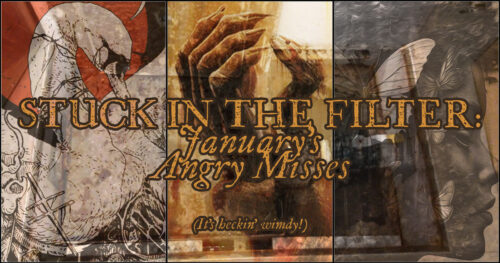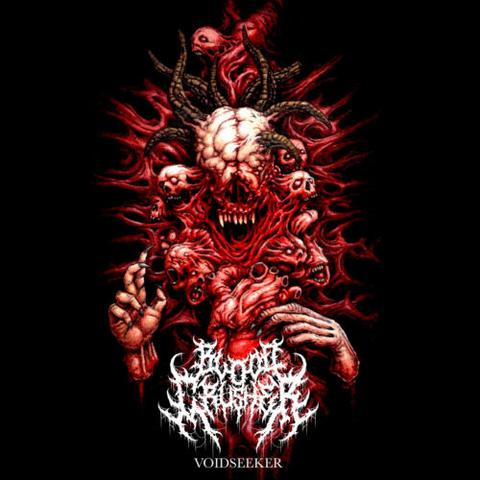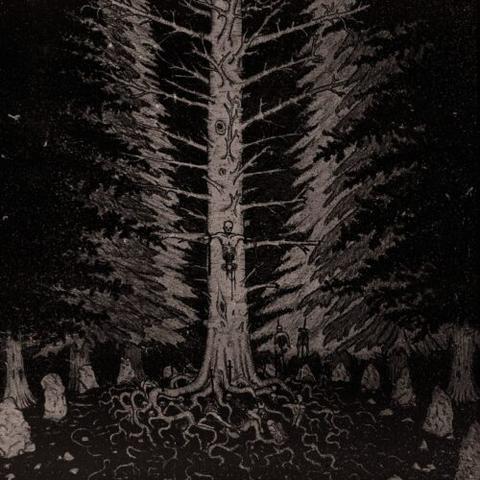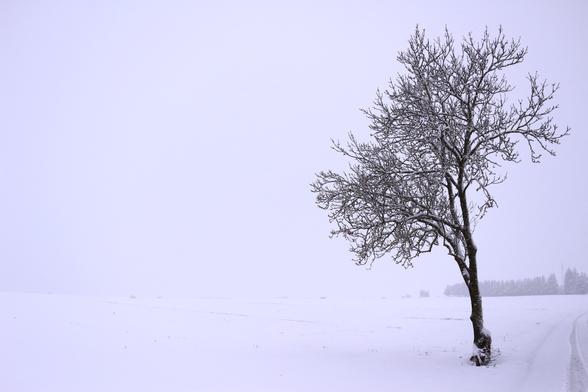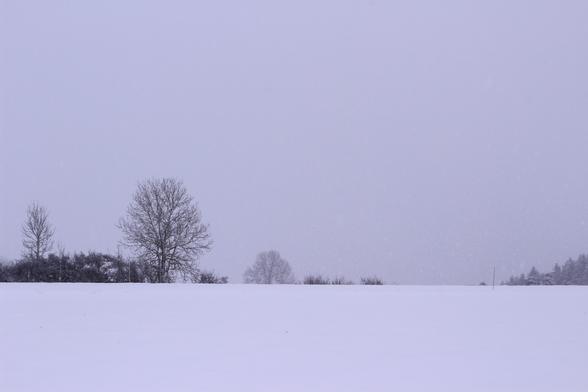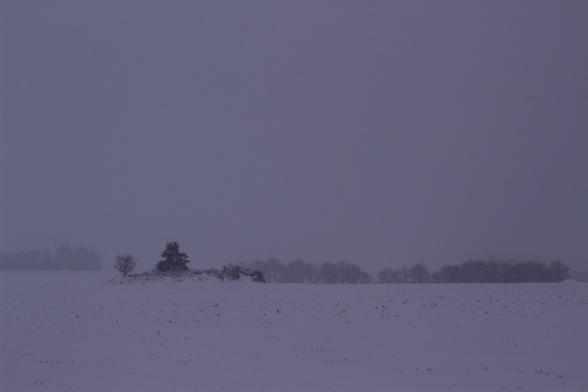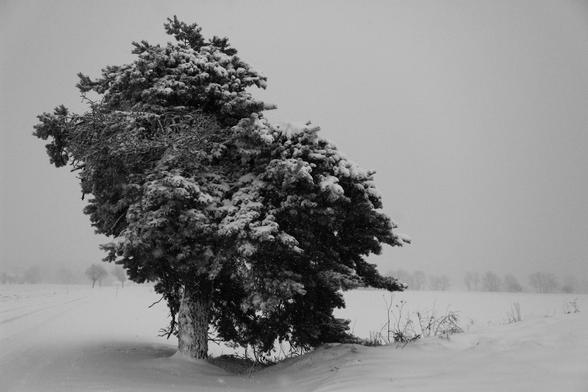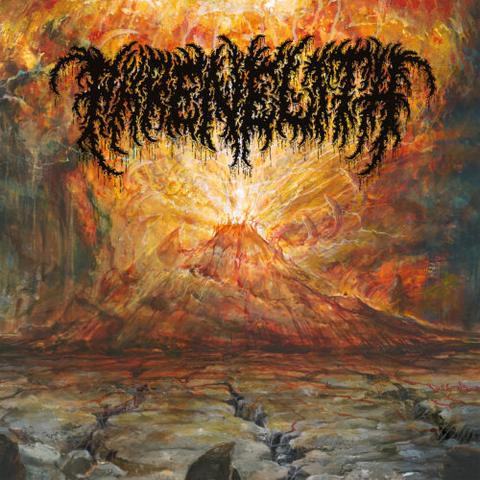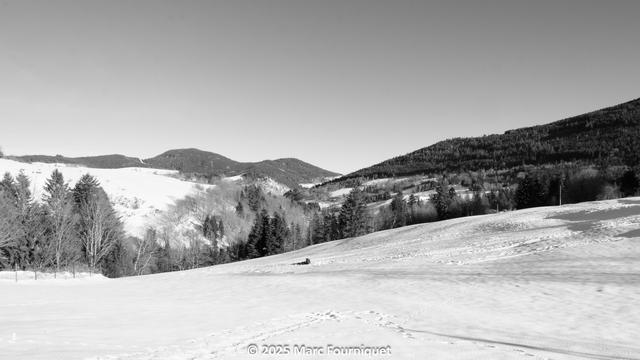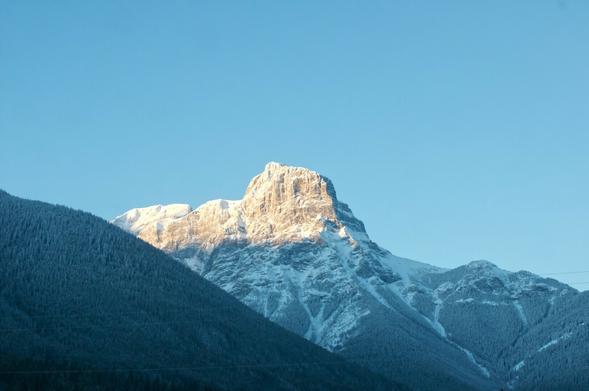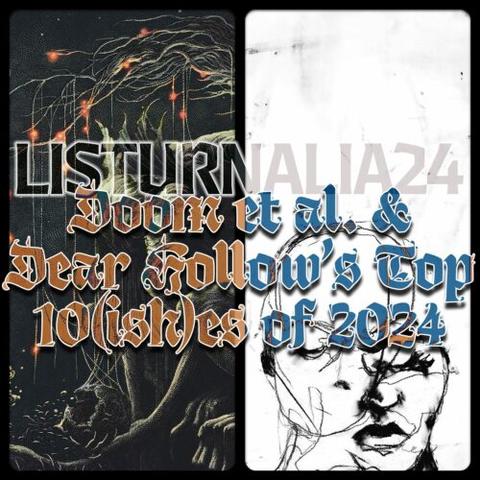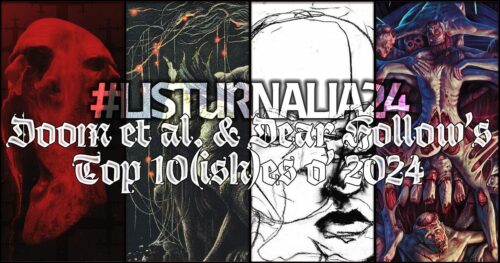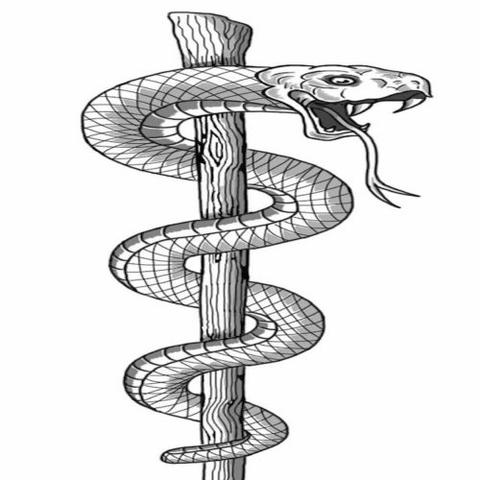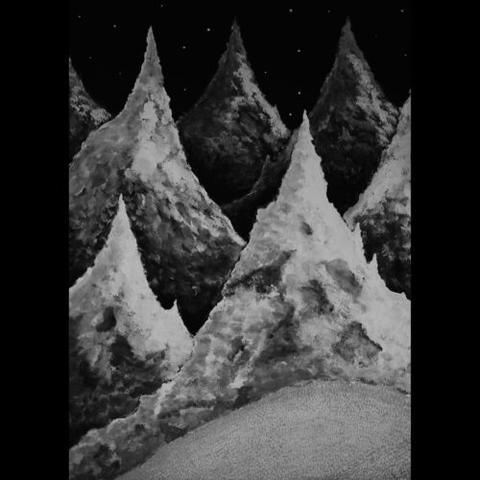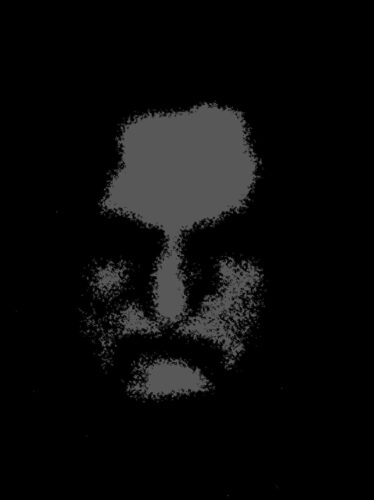#PaysageDHiver
Stuck in the Filter: January 2025’s Angry Misses
By Kenstrosity
We enter January under the impression that our underpowered filtration system couldn’t possibly get any more clogged up. Those blistering winds that overwhelm the vents with an even greater portion of debris and detritus pose a great challenge and a grave danger to my minions. Crawling through the refuse as more flies in all william-nilliam, my faithful lackeys brave the perils of the job and return, as they always do, with solid chunks of semi-precious ore.
And so I stand before you, my greedy little gremlins, in a freshly pressed flesh suit that only the elite like myself adorn, and present January 2025’s Filter finds. REJOICE!
Kenstrosity’s Fresh(ish) Finds
Bloodcrusher // Voidseeker [January 9th, 2025 – Barf Bag Records]
The sun rises on a new year, and most are angrier than ever. What’s a better way to process that anger than jamming a phat slab of brutal slamming deathcore into your gob, right? Oregon one-man-slammajamma Bloodcrusher understand this, and so sophomore outburst Voidseeker provides the goods. These are tunes meant not for musicality or delicacy but for brute-force face-caving. Ignorant stomps and trunk-rattling slams trade blows with serrated tremolo slides and a dry pong snare with a level of ferocity uncommon even in this unforgiving field (“Agonal Cherubim ft. Jack Christensen”). Feel the blistering heat of choice cuts “Serpents Circle ft. Azerate Nakamura” or “Death Battalion: Blood Company ft. The Gore Corps” and you have no choice but to submit to their immense heft. Prime lifting material, Voidseeker’s most straightforward cuts guarantee shattered PRs and spontaneous combustion of your favorite gym shorts as your musculature explodes in volume (“Slave Cult,” “Sanguis Aeternus,” “Blood Frenzy”). If you ask me, that sounds like a wonderful problem to have. As they pummel your cranium into dust with deadly slam riffs (“Malus et Mortis ft. Ryan Sporer,” “Seeker of the Void,” “Earthcrusher”) or hack and slash your bones with serrated tremolos (“Razors of Anguish,” “Methmouth PSA”), remember that Bloodcrusher is only trying to help.
Skaldr // Saṃsṛ [January 31st, 2025 – Avantgarde Music]
Virginia’s black metal upstarts Skaldr don’t do anything new. If you’ve heard any of black metal’s second wave, or even more melodic fare by some of my favorite meloblack bands like Oubliette, Stormkeep, and Vorga, Skaldr’s material feels like a cozy blanket of fresh snow. Kicking off their second record, Saṃsṛ, in epic fashion, “The Sum of All Loss” evokes a swaying dance that lulls me into its otherwordly arms. As Saṃsṛ progresses through its seven movements, tracks like the gorgeous “Storms Collide” and the lively “The Crossing” strike true every synapse in my brain, flooding my system with a goosebump-inducing fervor quelled solely by the burden of knowing it must end. Indeed, these short 43 minutes leave me ravenous for more, as Skaldr’s lead-focused wiles charm me over and over again without excess repetition of motifs or homogenization of tones and textures (“From Depth to Dark,” “The Cinder, The Flame, The Sun”). Some of its best moments eclipse its weakest, but weak moments are thankfully few and far between. In reality, Skaldr‘s most serious flaw is that they align so closely with their influences, thereby limiting Saṃsṛ‘s potential to stand out. Nonetheless, it represents one of the more engaging and well-realized examples of the style. Hear it!
Subterranean Lava Dragon // The Great Architect [January 23rd, 2025 – Self Release]
Formed from members of Black Crown Initiate and Minarchist, Pennsylvania’s Subterranean Lava Dragon take the successful parts of their pedigree’s progressive death metal history and transplant them into epic, fantastical soundscapes on their debut LP The Great Architect. Despite the riff-focused, off-kilter nature of The Great Architect, there lies a mystical, mythical backbone behind everything Subterranean Lava Dragon do (“The Great Architect,” “Bleed the Throne”). Delicate strums of the guitar, multifaceted percussion, and noodly soloing provide a thoughtful thread behind the heaviest crush of prog-death riffs and rabid roars, a combination that favorably recalls Blind the Huntsmen (“The Silent Kin,” “A Dream of Drowning”). In a tight 42 minutes, Subterranean Lava Dragon approaches progressive metal with a beastly heft and a compelling set of teeth—largely driven by the expert swing and swagger of the bass guitar—that differentiates The Great Architect from the greater pool of current prog. Yet, its pursuit of creative song structure, reminiscent of Obsidious at times, allows textured gradations and nuanced layers to elevate the final product (“A Question of Eris,” “Ov Ritual Matricide”). It is for these reasons that I heartily recommend The Great Architect to anyone who appreciates smart, but still dangerous and deadly, metal.
Thus Spoke’s Likeable Leftovers
Besna // Krásno [January 16th, 2025 – Self Release]
It was the esteemed Doom et Al who first made me aware of Solvakian post-black group Besna. 2022’s Zverstvá was charming and moving in equal respects, with its folky vibe amplifying the punch of blackened atmosphere and epicness. With Krásno, the group take things in a sharper, more refined, and still more compelling direction, showing real evolution and improvement. The vague leanings towards the electronic play a larger role (“Zmráka sa,” “Hranice”), but songs also make use of snappier, and stronger emotional surges (“Krásno,” “Mesto spí”), the polished production to the atmospherics counterbalanced sleekly by the rough, ardent screams and pleasingly prominent percussion. Krásno literally translates as ‘beautiful,’ and Besna get away with titling their sophomore so bluntly because it is accurate. Melodies are more sweeping and stirring (“Krásno,” “Oceán prachu,” “Meso spí”), and the integration of the harsh amidst the mellow is executed more affectively (“Hranice,” “Bezhviezdna obloha”) than in the band’s previous work. Particularly potent are Krásno’s subtle nods and reprises of harmonic themes spanning the record (“Krásno,” “Oceán prachu,” “Mesto spí”), recurring like waves in an uplifting way that reminds me of Deadly Carnage‘s Through the Void, Above the Suns. Barely scraping past half an hour, the beautiful Krásno can be experienced repeatedly in short succession; which is the very least this little gem deserves.
Tyme’s Ticking Bomb
Trauma Bond // Summer Ends. Some Are Long Gone [January 12, 2025 – Self-Released]
Conceptualized by multi-instrumentalist Tom Mitchell1 and vocalist Eloise Chong-Gargette, London, England’s Trauma Bond plays grindcore with a twist. Formed in 2020 and on the heels of two other EPs—’21’s The Violence of Spring and ’22’s Winter’s Light—January 2025 sees Trauma Bond release its first proper album, Summer Ends. Some Are Long Gone, the third in a seasonally themed quadrilogy. Twisting and reshaping the boundaries of grindcore, not unlike Beaten to Death or Big Chef, Trauma Bond douses its grind with a gravy boat full of sludge. Past the moodily tribal and convincing intro “Brushed by the Storm” lies fourteen minutes of grindy goodness (“Regards,” “Repulsion”), sludgian skullduggery (“Chewing Fat”), and caustic cantankerousness (“Thumb Skin for Dinner”). You’ll feel violated and breathless even before staring down the barrel of nine-and-a-half minute closer “Dissonance,” a gargantuanly heavy ear-fuck that will liquefy what’s left of the organs inside your worthless skin with its slow, creeping sludgeastation. I was not expecting to hear what Trauma Bond served up, as the minimalist cover art drew me in initially, but I’m digging it muchly. Independently released, Summer Ends. Some Are Long Gone is a hell of an experience and should garner Trauma Bond a label partner. I’ll be hoping for that, continuing to support them, and looking forward to whatever autumn brings.
Iceberg’s Bleak Bygones
Barshasketh // Antinomian Asceticsm [January 9th, 2025 – W.T.C Productions]
My taste for black metal runs a narrow, anti-secondwave path. I want oppressive, nightmarish atmosphere, sure, but I also crave rich, modern production and technically proficient instrumental performances. Blending the fury of early Behemoth, the cinematic scope of Deathspell Omega, and the backbeat-supported drones of Panzerfaust, Barshasketh’s latest fell square in my target area. The pealing bells of “Radiant Aperture” beckoned me into Antinomian Asceticsm’s sacred space, a dark world populated with rippling drum fills, surprisingly melodic guitar work, and a varied vocal attack that consistently keeps things fresh. With the average track length in the 6-minute territory, repeat listens are necessary to reveal layers of rhythm and synth atmosphere that give the album its complexity. A throwaway interlude (“Phaneron Engulf”) and a drop in energy in the second and third tracks stop this from being a TYMHM entry, but anyone with a passing interest in technical black metal with lots of atmosphere should check this out.
Deus Sabaoth // Cycle of Death [January 17th, 2025 – Self-Released]
Deus Sabaoth have a lot going for them to catch my attention, beyond that absolutely entrancing cover art. Released under the shadow of war, this debut record from the Ukrainian trio bills itself as “Baroque metal,” another tag that piqued my interest. Simply put, Deus Sabaoth play melodic black metal, but there’s a lot more brewing under the surface. I hear the gothic, unsettled storytelling of The Vision Bleak, the drenching laments of Draconian, and the diligent, dynamic riffing of Mistur. The core metal ensemble of guitar, bass and drums is present, but the trio is augmented by a persistent accompaniment of piano and strings. The piano melodies—often doubled on the guitar—are where the baroque influence shines the greatest, echoing the bouncing, repetitive styling of a toccata (“Mercenary Seer,” “Faceless Warrior”). The vocals are something of an acquired taste, mainly due to their too-far-forward mix, but there’s a vitality and drive to this album that keeps me hooked throughout. And while its svelte 7 song runtime feels more like an EP at times, Cycle of Death shows enough promise from the young band that I’ll keep my eyes peeled in the future.
GardensTale’s Tab of Acid
I Don’t Do Drugs, I Am Drugs // I Don’t Do Drugs, I Am Drugs [January 27th, 2025 – Self-released]
When you name yourself after a famous Salvador Dalí quote, you better be prepared to back it up with an appropriate amount of weird shit. Thankfully, I Don’t Do Drugs, I Am Drugs strives to be worthy of the moniker. The band’s self-titled debut is a psychedelic prog-death nightmare of off-kilter riffs, structures that seem built upon dream logic, layers of ethereal synths and bizarre mixtures of vocal styles. The project was founded by Scott Hogg, guitarist for Cyclops Cataract, who is responsible for everything but the vocals. That includes all the songwriting. Hogg throws the listener off with an ever-shifting array of Gojira-esque plodding syncopation and thick, throbbing layers of harmonics that lean discordant without fully shifting into dissonance. But the songs float as easily into other-worldly soundscapes (“The Tree that Died in it’s[sic] Sleep”) or off-putting balladry (“Confierous”). BP of Madder Mortem handles vocals, and he displays an aptitude for the many facets required to buoy the intriguing but unintuitive music, his shouts and screams and cleans and hushes often layered together in strange strata either more or less than human. The combined result resembles a nightmare Devin may have had around 2005 after listening too much Ephel Duath. It’s not yet perfected; the ballad doesn’t quite work, and the compositions are sometimes a bit too dedicated to their lack of handholds. But it’s a hell of a trip, and a very convincing mission statement. A band to keep an eye on!
Dear Hollow’s Gunk Behooval
Bloodbark // Sacred Sound of Solitude [January 3rd, 2025 – Northern Silence Productions]
Bloodbark’s debut Bonebranches offered atmospheric black metal a minimalist spin, as cold and relentless as Paysage d’Hiver, as textured as Fen, and as barren as the mountains it depicts, exuding a natural crispness that recalls Falls of Rauros. Seven years later, we are graced with its follow-up, the majestic Sacred Sound of Solitude. Like its predecessor, the classic atmoblack template is cut with post-black to create an immensely rich and dynamic tapestry, lending all the hallmarks of frostbitten blackened sound (shrieks, blastbeats, tremolo) with the depth of a more modern approach. Twinkling leads, frosty synths, and forlorn piano survey the frigid vistas, while the more furious blackened portions scale snowbound peaks, utilized with the utmost restraint and bound by yearning chord progressions (“Glacial Respite,” “Griever’s Domain”). A new element in the act’s sound is clean vocals (“Time is Nothing,” “Augury of Snow”), which lend a far more melancholy vibe alongside trademark shrieking. Bloodbark offers top-tier atmospheric black metal, a reminder of the always-looming winter.
Great American Ghost // Tragedy of the Commons [January 31st, 2025 – SharpTone Records]
Boston’s Great American Ghost used to be extremely one-note, a coattail-rider of the likes of Kublai Khan and Knocked Loose. Deathcore muscles whose veins pulse to the beat of a hardcore heart, you’d be forgiven to see opener “Kerosene” as a sign of stagnation – chunky breakdowns and punk beats, feral barks and callouts, and a hardcore frowny face sported throughout. But Tragedy of the Commons is a far more layered affair, with echoes of metalcore past (“Ghost in Flesh,” “Hymns of Decay”), pronounced and tasteful nu-metal influence a la Deftones (“Genocide,” “Reality/Relapse”), and more variety in their rhythms and tempos, reflecting a Fit for an Autopsy-esque cutthroat intensity and ominous crescendos alongside a more pronounced influence of melody and manic dissonance (“Echoes of War,” “Forsaken”). Is it still meatheaded? Absolutely. Are its more “experimental” pieces in just well-trodden paths of metalcore bands past? Oh definitely. But gracing Great American Ghost a voice beyond the hardcore beatdowns does Tragedy of the Commons good and gives this one-trick pony another trail to wander.
Steel Druhm’s Detestible Digestibles
Guts // Nightmare Fuel [January 31st, 2025 – Self-Release]
Finland’s Guts play a weird “caveman on a Zamboni” variant of groove-heavy death metal that mixes OSDM with sludge and stoner elements for something uniquely sticky and pulversizing. On Nightmare Fuel, the material keeps grinding forward at a universal mid-tempo pace powered by phat, crushing grooves. “571” sounds like a Melvins song turned into a death metal assault, and it shouldn’t work, but it very much does. The blueprint for what Guts do is so basic, but they manage to keep cracking skulls on track after track as you remain locked in place helplessly. Nightmare Fuel is a case study into how less can be MOAR, as Guts staunchly adhere to their uncomplicated approach and make it work so well. Each track introduces a rudimentary riff and beats you savagely with it for 3-4 minutes with little variation. Things reset for the next track, and a new riff comes out to pound you into schnitzel all over again. This is the Guts experience, and you will be utterly mulched by massive prime movers like “Mortar” and “Ravenous Leech,” the latter of which sounds like an old Kyuss song refitted with death vocals and unleashed upon mankind. The relentlessly monochromatic riffs are things of minimalist elegance that you need to experience. Nightmare Fuel is a slow-motion ride straight into a brick wall, so brace for a concrete facial.
#2025 #AmericanMetal #AntinomianAsceticism #AtmosphericBlackMetal #AvantgardeMusic #BarfBagRecords #Barshasketh #BeatenToDeath #Behemoth #Besna #BigChef #BlackCrownInitiate #BlackMetal #BlindTheHuntsmen #Bloodbark #Bloodcrusher #BrutalDeathMetal #Converge #CycleOfDeath #CyclopsCataract #DeadlyCarnage #DeathMetal #Deathcore #DeathspellOmega #Deftones #DeusSabaoth #DevinTownsend #DoomMetal #Draconian #EphelDuath #FallsOfRauros #Fen #FitForAnAutopsy #Gojira #GothicMetal #GreatAmericanGhost #Grind #Grindcore #Guts #Hardcore #IDonTDoDrugsIAmDrugs #Jan25 #KnockedLoose #Krásno #KublaiKhan #MadderMortem #MelodicBlackMetal #Minarchist #Mistur #NightmareFuel #NorthernSilenceProductions #NuMetal #Oubliette #Panzerfaust #PaysageDHiver #PostBlack #ProgressiveDeathMetal #ProgressiveMetal #Review #Reviews #SacredSoundOfSolitude #SamSr_ #SelfRelease #SharpToneRecords #Skaldr #Slam #SlovakianMetal #Sludge #Stormkeep #StuckInTheFilter #SubterraneanLavaDragon #SummerEndsSomeAreLongGone #TheGreatArchitect #TheVisionBleak #TragedyOfTheCommons #TraumaBond #UKMetal #UkranianMetal #Voidseeker #Vorga #WTCProductions
Aspaarn – Oblations in Atrocity Review
By Dear Hollow
Shockingly, raw black metal isn’t really known for its accessibility. Its cult utilizes the most discordant of black metal’s already discordant approaches, but its worshipers may notice the range of barbed noise to cloaks of fuzz that populate lo-fi productions. Switzerland’s one-man raw black show Aspaarn utilizes both clarity and opacity alike to cast shadows of a dark wilderness worthy of its cover, with just enough reverb to lend a ghostly presence wandering amid the thickets and pines. While the stereotype lands in moonlit purple castles and catacombs of dust and shadows, there’s a distinctly wild and uncharted feeling about Aspaarn.
The phrase “raw black” doesn’t always wrap up neatly in a Nattens Madrigal-shaped box, and Aspaarn’s sound reflects this complexity. While reveling in that classic barbed clarity of Ildjarn, its ghostly haze recalls the likes of Revenant Marquis, adding to the disorientation. It ultimately ends up sounding a bit like Kryatjurr of Desert Ahd or El-Ahrairah: classically bleak and morbid black metal chord progressions wildly transfigured into a psychedelic and otherworldly visage. Composed of multi-instrumentalist Solaris Lupus, also of the likeminded Lord Valtgryftåke and Svartokunnighet, the Aspaarn project’s fourth full-length Oblations in Atrocity oscillates between second-wave frigid rawness and atmospheric wherewithal that never forsakes its teeth.
In spite of the genre of choice, Aspaarn’s instrumental attack is surprisingly clear, and Lupus’ grasp on songwriting is very firm. Layers of tremolo and bass lead the attack, with the inherent dissonance and minor keys giving Oblations in Atrocity a disorienting feeling (“Duty in Hecatomb,” “Boundless Hunger”), further emphasized by shifting tempos and rhythms, often taking a mad waltz reminiscent of Grave Pilgrim. Drums anchor this sound with precision and reliability, but a sharper trash-can-lid snare graces it a nimbleness that adds a distinct insanity to it as well (“The Order of Fear,” “Memories in Suffering”). Chord progressions are the backbone of every track and are directly rooted in classic Darkthrone’s permafrost soil, allowing its morbid and morose atmosphere to shine in the best possible way. The balance between clarity and opacity is key, as rawness and noise can tend to overwhelm basic musical movement, but Aspaarn’s deft hand manages to keep it surprisingly restrained.
While clarity adds that kvlt intensity and relentless attack, the tools guiding opacity in Oblations in Atrocity give it its supernatural lean. Vocals are most obvious right off the bat, with Lupus’ shrieks and roars cloaked in a thick veil of reverb, giving it a far more haunting feeling than many raw black metal stereotypes. When clean vocals are utilized, they take on a choral quality, nearly liturgical, driving home the album’s blasphemous atmosphere (“Silence of the Gods,” “All Reaching Misery”). One thing that puts Aspaarn in distinction is its ability to sound atmospheric without an overreliance on synths or keys, like genre greats Paysage d’Hiver or Lunar Aurora. In fact, there are very few obvious occurrences of “ambient” vestiges apart from the closer, which just drives home the second-wave worship that pervades Oblations in Atrocity.
For all the balance and atmospheric prowess Aspaarn offers with Oblations in Atrocity, it remains raw black metal, a particularly divisive and unfriendly take on an already divisive and unfriendly style. The vocals, while contributing to the otherworldly and supernatural feel in ways I saw as a clear highlight, are quite loud and can overwhelm the sound. The jarring tempo and rhythm changes, guided by the feral drumming, are an acquired taste but ultimately guide the labyrinthine panic and uncharted wilderness that course through the album. The first half of closer “All Reaching Misery” feels painfully directionless until the atmospheric passages give them purpose. What can I say, it’s raw black metal. Ultimately, Aspaarn has created an album that won’t change your mind about the style, but offers treats and bounties aplenty for those who like their music more with a generous side of pain.
Rating: 3.0/5.0
DR: 10 | Format Reviewed: PCM
Label: Self-Released
Website: töö kvlt för v
Releases Worldwide: February 15th, 2025
#2025 #30 #Aspaarn #AtmosphericBlackMetal #BlackMetal #Darkthrone #ElAhrairah #Feb25 #GravePilgrim #Ildjarn #KryatjurrOfDesertAhd #LordValtgryftåke #LunarAurora #OblationsInAtrocity #PaysageDHiver #RawBlackMetal #RevenantMarquis #Review #Reviews #SelfReleased #Svartokunnighet #SwissMetal #Ulver
#landscape #landscapephotography #photography #paysagedhiver #trees #nature #hauteloire #fixsaintgeneys
#landscape #landscapephotography #photography #paysagedhiver #trees #nature #hauteloire #fixsaintgeneys
#landscape #landscapephotography #photography #paysagedhiver #trees #nature #hauteloire #fixsaintgeneys
Phrenelith – Ashen Womb Review
By Alekhines Gun
In the early 2010’s, the world saw an explosion of the New-School-Old-School Revival of death metal. Spearheaded by outfits like Tomb Mold, Gatecreeper, Hyperdontia, and Undergang—to name but a few—this wave of bands represented taking the crust, filth, and savagery of your favorite genre founding fathers and launching them forth with wrath into of the modern era. Standing shoulder to shoulder near the front of this pack was Phrenelith, a Danish group whose debut Desolate Landscape made them scene darlings almost overnight. Unfortunately, sophomore release Chimaera opted for an increase in muck and atmospheric decor at the cost of some of their first album’s power, and was received somewhat divisively. Now, some four years later, Ashen Womb is prepared to drop like an anvil on their unsuspecting fanbase. Will they continue to dive into the murky wells, or has this womb been gestating a return to glorious, bone-powdering violence?
As it turns out, Phrenelith have opted for option C. The approach of Ashen Womb, in both music and sound, pitches for a merging of the melancholy of Chimaera with Desolate Landscape’s cement-shattering methodology to songwriting. The production sidesteps both previous releases, at once managing to be muddy in its tone with leads vibrant enough to cut through the mire. Making his LP debut, drummer Andreas Nordgreen quickly etches his identity into the band, flowing between creative drum fills from measure to measure, giving repeated refrains in “Chrysopoeia” and “Astral Larvae” an engaging quality. Much like the artwork adorning the cover, the more melodic tones are buried but bright, even as bassist Jakob plays in tandem with guitar leads rather than chords, laying riffcraft to savage the crust below. The atypically warm DR lets everything shine in this paradoxical sonic quagmire, creating the suffocating character Chimaera opted for without sacrificing the clarity of barbarity at work.
Older fans will be stoked to hear the return to immediate violence in the compositions. Lead single “Stagnated Blood” toys with a repeated riff at alternating octaves, stringing together hooks and character into a ruthless scorched earth assault. “A Husk Wrung Dry” rocks an infected 7/4 riff replete with whammy abuse and staccato-laced chords which slide from bouncy to bludgeoning. Guitarists David and Simon Daniel toy with bends, modulation, and sustained tapping sections recalling the more crystalline moments of Innumerable Forms, with Simon’s vocals a belligerent, reverb-soaked guttural soup. The vocals in particular are masterfully placed—both within the mix and the music—lyrical arrangement flawlessly adding titanic force to ruthless riffing while knowing when to be silent and let the music speak for itself.
Nonetheless, the specter of Chimaera looms betwixt the heavier moments, filling the negative spaces with gloom and somberness. Title track “Ashen Womb” and “Nebulae” end on repeated, haunting melodies, drawn out to a protracted conclusion. “Sphageion” serves as one of the better interludes I’ve heard, with tension-building distortion and Andreas breaking into a free-form drum solo which would go over swell in a live setting. Even the instrumental opener “Noemata” manages to carve an identity as a curtain-lifter rather than a pointless buildup, rendering Ashen Womb a journey rather than a mere collection of tracks. True, the atmospherics are sometimes heavy-handed; there’s no need to bookend songs with a cumulative couple minutes of Paysage d’Hiver-esque wind and sounds, and a minute could be trimmed off of both emotive fade-outs. Despite this, the mastery of seamless transitioning, rather than sandwiching of the disparaging elements gives Ashen Womb its own flavor in the Phrenelith landscape.
Few bands can manage to make each album its own time capsule of sound and style, but Ashen Womb accomplishes that and more, cementing Phrenelith as a band with chapters. Some may cling to the idea that Desolate Landscape is a collection of better songs, but Ashen Womb is a better album; a journey with highs, lows, and tension-building. By managing to merge the melodicism and mood with the brutality, rather than sacrificing one for the other, these Danes have continued to evolve their sound in an admirable direction. Who can say where the fourth release will take us? One thing’s for sure: it won’t be what any of us expect, other than a commitment to high quality, lethal weapons grade, unadulterated death.
Rating: 3.5/5.0
DR: 8 | Format Reviewed: 320 kbps mp3
Label: Dark Descent Records
Websites: https://darkdescentrecords.bandcamp.com/album/ashen-womb | https://www.facebook.com/phrenelith/
Releases Worldwide: February 7, 2025
#2025 #35 #AshenWomb #DanishMetal #DarkDescentRecords #DeathMetal #Feb25 #Gatecreeper #Hyperdontia #InnumerableForms #PaysageDHiver #Phrenelith #Review #Reviews #TombMold #Undergang
#neige #paysagedhiver #snow #vosges #coldubonhomme #nikond7200 #nikonphotography #nikonpassion
#forest #mistyforest #foret #arbre #jaimelesarbres #trees #hiver #paysagedhiver #vendee #france
Mes notes partagées à l'époque:
"Regardez au cœur de la nature, tout sera alors plus simple." Albert Einstein.
J'ai pris cette photo le matin du jour de Noël à Banff, Alberta.
Ce paysage me manque énormément. Je suis de retour à Montréal pendant quelques heures avant de repartir à l'aventure (cette fois vers les Caraïbes) mais mon cœur est resté dans les montagnes de l'ouest.
Instagram: https://www.instagram.com/p/BOgQyMdj72f/
500px: https://500px.com/photo/189955419/banff-december-25-2016-1-by-gersande-la-fleche
#Banff #banffnationalpark #canadianrockies #Alberta #montagnes #landscapephotography #paysagedhiver
Doom_et_Al’s and Dear Hollow’s Top Ten(ish) of 2024
By Doom_et_Al
Doom_et_Al
2024 was the year my reviewing fell off a cliff.
I had plenty of good excuses. An infant son (Grayskull) who totally rocks my world but who gobbles up free time and good sleep habits like Pacman on a tear. A new role at the hospital, for which I was initially out of my depth, and that required enormous effort to stay afloat. An exhausting book tour for a memoir I published earlier this year. These are all incredible things for which I am extremely grateful. I just found that at the end of every day, when I should have been critically assessing music, all I wanted to do was sleep.
This significant reduction in free time has forced me to reassess my relationship with metal. In the beforetimes, I would inhale it. I was not picky; the more the merrier. Now, I have to be judicious with what I listen to. I have a lower tolerance for bad music, and less inclination to listen to it multiple times. I sometimes yearned for a time when I could focus on music I wanted to listen to, not music I was being asked to critique. This caused me to wonder if I had any business reviewing music at all.
I can’t tell you if 2024 was a good year for metal or not, because the free time I had was focused on music that brought comfort. I therefore spun fewer albums, but those I did spin got a lot of earball time. I do know that despite everything, metal continued to bring me enormous joy and happiness. Part of this is thanks to the incredible AMG team, and AMG Himself, who have created, without question, the best metal site on the planet. Special thanks to the Steely One, who could have fired me many times, but didn’t for some reason. I’d also like to thank my fellow writers who are good, kind, supportive people whose only flaw is their collective questionable taste.
Returning to the question of why I’m still here: a few weeks ago, I was playing Gaerea softly on the stereo. Grayskull crawled in, heard the music, stood up, and with the biggest grin on his face, began growling and gesticulating. He was loving it, and his unbridled joy reminded me of how glorious good metal can be. It inspired me to try to review more next year. I hope some of that rubs off on you and that you have a beautiful, prosperous and happy 2025
#10. Sgáile // Traverse the Bealach – This type of noodly prog isn’t usually my thing. But Sgáile’s Traverse the Bealach is so damn catchy and epic that it transcends the usual pitfalls of the sub-genre. Importantly, it captures the essence and majesty of the Scottish Highlands (albeit in post-apocalyptic form) in a way matched only, perhaps, by countryman Saor. It’s also an album that improves the longer you listen to it. An unexpected delight.
#9. Misotheist // Vessels by Which the Devil is Made Flesh – A band that hasn’t forgotten that black metal is supposed to feel ugly and dangerous, Vessels picks up where For the Glory of Your Redeemer left off, and is just as remorseless, claustrophobic and scary as its predecessors. Misotheist do their usual thing and knock out 3 dissonant bangers in under 40 minutes. When people complain that black metal has gone soft, point them in the direction of Misotheist
#8. Dissimulator // Lower Form Resistance – Thrash so tasty, even non-thrash fans like myself had to take notice. Complex, technical, ferocious… the only thing I don’t love is the vocals, and those I can get past because the rest is so good. Loaded with killer riffs from start to finish, this should appease the cave-man in you, while tickling those neurones as well. This one stayed in rotation for me all year. Thrash never does that. Which should tell you all you need to know.
#7. Spectral Wound // Songs of Blood and Mire – Although not as immediately spectacular as its predecessor, Songs of Blood and Mire is still a ferocious collection of vital and vivid black metal. Melding melodicism with fury, Spectral Wound create music as monstrous as it is catchy. Perhaps because it lacks the outright bangers of A Diabolic Thirst, perhaps because it is even more caustic, this one flew under many a radar. Don’t let it fly under yours.
#6. Kanonenfieber // Die Urkatastrophe – Building on the promise exhibited in earlier albums and EPs, Kanonenfieber realize their full potential with Die Urkatastrophe. So aggressive, so confident, so accomplished that I knew after one listen that it would list. The notion that “war is hell” is patently clichéd, yet Kanonenfieber subvert the usual trappings by cleverly mixing the faux-sunniness of war propaganda with the brutality of black metal. It works brilliantly.
#5. Selbst // Despondency Chord Progressions – Don’t let the hideous AI art turn you off. Selbst have come out of nowhere to create the year’s most chaotic, yet compelling, collection of tracks. Channelling Suffering Hour, this is music that finds the beauty in the messiness of its composition. Miraculously, the insanity never becomes wearying, only more interesting. By the time the final chords fade, you’ll want to throw yourself in all over again.
#4. Dawn Treader // Bloom & Decay – File under “surprise of the year.” I nearly snapped this one up from the promo sump, and then, like an idiot, passed it by. Joke’s on me. Capturing the warm, fuzzy side of black metal (a la Deafheaven, or a good version of Ghost Bath), Dawn Treader manages to pack a deep emotional punch despite all the prettiness on display. Alcest’s effort this year was fine… but when I wanted that transcendent experience only good black metal can provide, it was to Bloom & Decay that I kept returning.
#3. Gaerea // Coma – Gaerea have always been absolute masters of catharsis. The ability to take music that is baseline intense, and ratchet it up even further, is a rare gift. With Coma, Gaerea dial things back. Their tenderest, most intimate collection benefits from adding a gentler emotional core. This makes Coma less immediate than, say, Mirage,but ultimately more varied. And when it hits, the highs are some of the best of Gaerea’s rock-solid career.
#2. Ulcerate // Cutting the Throat of God – Arguably the best band in metal release another absolute barnstormer. Using every trick learned over the previous albums, Ulcerate deploy a devastating assault of dissonant death metal that captivates as it overwhelms. Insane drumming, complex time shifts, forceful melodies, thematic cohesion… Cutting the Throat of God has it all.
#1. Iotunnn // Kinship – First things first. Kinship not Access All Worlds Part 2. It’s more ambitious. It’s more sprawling. It’s shaggier and looser. And truthfully, on my first few listens, I thought it was a bit bloated and ill-disciplined. A 4.5 hiding in a 3.0, if you will. But a weird thing happened. I kept coming back. And every time I came back, I discovered something new. The incredible cymbal work on the chorus of “Mistland,” the gorgeous ending of “The Anguished Eternal.” Soon I realized Kinship, and its songs, are exactly as long as they need to be. Jon Aldara’s amazing vocal work elevates the stellar material even further, adding emotional complexity and yearning to the spell-binding complexity. The result is ethereal, complex, spiritually satisfying prog-death. It’s the best album of the year.
Disappointment o’ the Year:
Zeal & Ardor // Greif – I love the band. The live show still rocks. But this is a disappointing misfire.
Songs o’ the Year
- “Silver Leaves” – Wintersun
- “Mistland” – Iotunn
- “A Mercy Fall” – Counting Hours
- “Withering Flower” – Gaerea
- “Neuronal Fire” – Dark Tranquillity
- “Matricide 8:21” – Fleshgod Apocalypse
Dear Hollow
Welcome to the end of 2024! We at AMG hope the year has been kind to you – that your lives are filled with love, your hearts with joy, and our world with peace. I hope that you have found your people, and have those you can lean on. If we have ever given you a voice, a platform, or just love and support when you need it, then we have done our jobs.
2024 has been a roller coaster for the Hollow household. Our toddler is now a three-year-old encroaching on kidhood, with all the sass and sick burns she can muster.1 Fun news: we will be welcoming another kiddo into the world come summer of 2025! I also finally graduated with my master’s in secondary education this past year (mainly for the pay raise). While I’m unsure how much I will use from those classes, I have stepped up my class offerings to science fiction, true crime, and archaeology, alongside myriad others.
My metal reviewing has found a bit of a crossroads in 2024. At the end of 2023, I was diagnosed with anxiety and depression with potential ADHD, with a ton of childhood patterns and religious trauma rooted in my upbringing. As I unpack my need for productivity, I have had to take some steps back and see where my values actually lie as I’ve acclimated to medication, counseling, and just trying to rewire my brain. I’ve been reading and relaxing more, instead of cranking out reviews as religiously as I have. I’m trying to live without religion – of any kind.
Special shout-outs to those who have been instrumental in my journey this year: the ineffable and tireless Steel Druhm, the genre-confusing Dolphin Whisperer, and those who have been supportive all year (Thus Spoke, Maddog, Carcharadon, Holdeneye, and Mystikus Hugebeard). Couldn’t have done it without y’all.
On to the metal!
#ish. Sumac // The Healer – The amorphous and fluid nature of The Healer is exactly what I’ve wanted out of post-metal. Its organicity is its greatest asset, accomplishing rich and trembling tones across its mammoth 76-minute runtime. Improvised material largely fails due to its lack of direction, but direction was never a focus for Sumac; rather, it dwells in its own devastation – the warhead and the fallout. Electronics simmer, noise erupts, sludge riffs hit with the weight of a thousand suns, and vocals command the attack with vitriol and mania alike. The Healer wounds and heals.
#10. Sidewinder // Talon – I never thought a stoner-inclined album would make it to my list, but here we are. I scoffed, but then the first riff of “Guardians” hit, and collided with vocalist Jem Tupe’s formidable and rich belts, the pleasure was so immense I threw a table over. The full-bodied, fuzzed-out blues riffs continue into jam seshes that keep me coming back for more, with them bluesy vocals floating like a weed-piloted spaceship atop the seas of psychedelia. The New Zealand act boasts range, zeniths in the low and slow, and cuts loose with southern fried riffage. I haven’t been able to shake the riff from “Prisoner” for months.
#9. Sleepytime Gorilla Museum // Of the Last Human Being – As a recent convert to 2004’s Of Natural History, Sleepytime Gorilla Museum scratches the itch I didn’t know I had. In essence, an art rock and jazz foray, Of the Last Human Being goes from snappy blasts of UneXpect-style metal meltdowns, multilayered vocal attacks, wonky and hypnotizing dream sequences,2 to brass drawls, anachronistic industrial electronic, to art-funk, and more! Sleepytime Gorilla Museum is confidently locked into its own stylistic fluidity – Of the Last Being picks up as if seventeen years haven’t passed since its predecessor.
#8. Mamaleek // Vida Blue – Taking what made predecessor Diner Coffee so great and blowing it up with a palpable pomp, Vida Blue simultaneously pays homage to member Eric Livingston and the relocation of the Oakland Athletics to Las Vegas. Mamaleek establishes these tracks upon much shiftier sands, free jazz at its core, while jazz- and blues rock, post-punk, prog-rock, and pure experimentalisms are glossed over progressions rotten to the core. From flute and brass explosions to anarchic punk driving, you’d be hard-pressed to find an album as bewildering – and as utterly brilliant – as Vida Blue. Home run or whatever.
#7. Thou // Umbilical – While Thou has always been excellent, Umbilical foregoes the post-metal sensibilities that populated Heathen and Summit in favor of a cutthroat hardcore influence. Blessedly, while it feels harsher than much of their previous material, it doesn’t change the core that defines this Baton Rouge collective. Doom and sludge still dominate the pain and smothering that Umbilical represents, with the thick riffs reeking with the putridity of swamp water and vocals haunting with the vitriol of the bayou’s ghosts dominating the ears aplenty, with a vicious hardcore urgency biting through the humidity.
#6. Ataraxie // Le Déclin – The bleak edge of funeral doom has never felt so appealing. Recalling Ingmar Bergman’s The Seventh Seal in its audio and existential weight, the French collective balances the heft of funeral doom with the punishment of death metal – without the bells and whistles of modern atmospherics. Leads dominate the melodic portions with mobility and competence, death metal collapses regularly imminent, tension and bleakness hanging high in an empty sky. Four tracks of patient starkness greet the ears with overwhelming weight and tortured meditations on devastation.
#5. Ingurgitating Oblivion // Ontology of Nought – Easily my most returned-to album of 2024, the German duo creates a death metal album that embodies the outer extremes of the style. It’s dissonant beyond what many consider dissonant, punishing beyond what’s considered punishing, and easily one of the most exploratory albums of the year. Five long-form tracks showcase labyrinthine songwriting, experimental melodic structures, mind-flaying technicality, and a strange sense of catchiness radiating from deep within. Perhaps the most puzzling release of the year that requires and demands your full attention, the unearthed rewards are plenty.
#4. Orgone // Pleroma – Stephen Jarrett emerges from a ten-year hiatus of Orgone for a definitive piece of metal that defies explanation. Featuring a technicality that exists in a league of its own with an adventurousness and organicity that aligns its vast range of influences neatly, with its core landing somewhere among technical death metal and post-hardcore a la Amia Venera Landscape. Riffs and sweeps maintain a certain unhinged and intensely calculated tedium, while stylistic wilderness is explored in real-time. Post-metal, death metal, post-hardcore, and jazz are all tied together with crescendos and organic breadth that sway from lush harmony to scathing dissonance seamlessly. Orgone returns with an opus and pilgrimage of beauty, adventure, and pain.
#3. Ulcerate // Cutting the Throat of God – I was this close to writing off Ulcerate’s newest as too accessible and too forward, lacking the atmospheric prowess of The Destroyers of All or Stare Into Death and Be Still. Then I let Cutting the Throat of God whisper and breath. In between these stormy blusters came the answer, and a sentience emerged. It wasn’t about a broad showcase of dissonance and technical prowess, but a holistic cohesion that stitches the music together with the nuance and sinews of being. The vicious and the ethereal blended into unspoken horror, with meditations ranging from the frantic to the morbid. Cutting the Throat of God is the most human of its releases but in the tragedy it becomes and the metamorphosis it undergoes – the murder of God.
#2. Aborted // Vault of Horrors – I’ve never been terribly keen on the Belgian deathgrind legends, but Vault of Horrors curb-stomped a special place in me – namely because it sounds like deathcore. I’m not willing to banter about that specificity, but all I know is that Vault of Horrors kicks serious ass. Ripping tempos, bludgeoning riffs, and an unhinged technicality align for an album deserving of the act’s reputation, bolstered by a legion of guests.3 Highlight after highlight rolls by with reckless abandon and pulverizing intensity, until your body is so bruised and beaten you have nothing else to offer. I don’t care if it’s deathcore; it’s brutal, bouncy, and wicked, and I’m just happy to have my skull caved in.
#1. Convulsing // Perdurance – Thinking of the meteoric trajectory of Australian one-man project Convulsing and its albums, it’s no wonder that Perdurance has lasting success. Dissonant death metal has a high standard this year with established juggernauts Ulcerate, Gigan, Mitochondrion, Devenial Verdict, Pyrrhon, Replicant, and Ingurgitating Oblivion releasing scathing blight upon the world in monolithic and ruthless fashion. In this way, Perdurance takes the world in a whisper. Encapsulating a sound that is both unforgivingly dense and painfully claustrophobic, while also starkly and lushly atmospheric in its layered crescendos and exploratory songwriting, few artists profess the level of songwriting the way sole member Brendan Sloan utilizes: intricate and gradual evolution of riffs and melodies, achieving a level of organicity and sentience seen by few. Twisting convention with a knife firmly planted in devastation, Perdurance achieves a truly iconic and transcendent voice in the best album of the year.
Honorable Mentions:
- Paysage d’Hiver // Die Berge – It might not best Im Wald, but it’s a damn good conclusion to the Wanderer’s journeys, scathing black metal and frigid ambiance conjuring the majesty of mountains.
- Stenched // Purulence Gushing from the Coffin – I’ve never quite gotten what Steel Druhm has been on about with filthy, putrid death metal, but now I get it. Ugh, I need to take a shower.
- Defeated Sanity // Chronicles of Lunacy – Brutal death metal darlings don’t hesitate to bring the ouchy, but armed with enough technicality and insanity to keep us guessing, it’s a tough album to beat.
- Apes // Penitence – What appeared to be a total Nails ripoff turned out to be a much more atmospheric and thoughtful affair, the Quebecois group still managing to cave my skull in.
- Pillar of Light // Caldera – With a pulverizing yet restrained palette aimed at evocation through sludge and post-metal, this Detroit collective scratches the itch that only Amenra could have.
- Charli XCX // Brat – Well, color me Brat green and call me 2012 The Hobbit’s portrayal of the Misty Mountains. It’s a pop album that caught me by surprise. Hooks and experimental sensibilities align with a deceptively bare-bones album with a strong and palpable theme coursing through. I have not been able to get “Sympathy is a Knife” out of my head.
Biggest Surprises:
- Everyone and their Kitchen Sink // La Suspendida – What. The. Fuck.
- Jeris Johnson // Dragonborn – “Siren’s Song” is a perfect holiday track, as it interpolates the central melody of “What Child is This?”!!! Merry fucking Christmas. God.
- Two La Torture des Ténèbres albums in one year – I like it raw, boys.
- Three Monolith records in one year: blackened hardcore, doom/deathcore, and aquatic atmoblack. Impressive, fellas.
- How crucial darkwave bands Lazerpunk, Perturbator, and Sleepless Droids were to finishing my master’s. Thanks for the recommendations, Mystikus!
Songs o’ the Year:
- Assemble the Chariots – “Evermurk”
- Firtan – “Hrenga”
- Melvins – “Pain Equals Funny”
- Shiverboard – “Vitamins of Darkness”
- Convulsing – “Endurance”
- Charli XCX – “Sympathy is a Knife”
#2024 #Aborted #Apes #Ataraxie #CharliXCX #Convulsing #DawnTreader #DefeatedSanity #Dissimulator #DoomEtAlSAndDearHollowSTopTenIshOf2024 #Gaerea #IngurgitatingOblivion #Iotunn #Kanonenfieber #Mamaleek #Misotheist #Orgone #PaysageDHiver #PillarOfLight #Selbst #Sgaile #Sidewinder #SleepytimeGorillaMuseum #SpectralWound #Stenched #Sumac #Thou #Ulcerate #ZealAndArdor
Sarcophagum – The Grand Arc of Madness
By Alekhines Gun
Side projects are a staple in all genres of music, and metal is no exception. Some projects are used to explore new ideas that would be out of place in a musician’s main outfit (Spectral Voice), with others to express themselves in a more individualized setting (Corpsegrinder). But what if members of a band decided they could do the same thing as their old and current outfit, but better? Enter Sarcophagum. Created by current and past members of Golgothan Remains, this Sydney Australia studio project wasted no time crafting a debut EP in 2022 and released a stand-alone single just last year. Now, they stand poised to deliver their first full-length, The Grand Arc of Madness. Does this side project deserve to leave the shadow of its predecessors?
Sarcophagum play a brand of treble-heavy death metal which focuses on overwhelming the listener with hypnotic heft rather than brute force. While the previously reviewed Golgothan Remains outings channel a brand of Ulcerate by way of caveman intensity and bludgeoning, Sarcophagum distinguish themselves by toning down the raw attack into something more akin to the engorged tonal clusters of Suffering Hour. Throw in just a hint of Gorguts skronk for ugly atmosphere, and you have a sound that teeters from the enchanting to the repugnant. This slightly cleaner presentation allows the band to alternate between straightforward tension-laced chug fests in “Ritual Pillars Burn” to atmospheric, sustained progressions in “Vermiform.” Across four songs and 34 minutes, The Grand Arc of Madness attempts to concoct a menacing atmosphere where moments of stark beauty are set apart by the discomfort of jarring time signature shifts and melodies collapsing into clashing, overlapping heaps of noise.
The man who makes this all work is the drummer and star of the album, Robin. His drumming style is Sarcophagum’s secret sauce, using a mastery of cymbal-only fills, well-timed double bass drills, and the ability to pull back or fill the empty space. This couples nicely with axe-men Matt and Adam’s use of repetition and looping riffs, allowing a constant yin and yang of sound. “Feudal Futures” exemplifies this formula, with Robin going berserk over his kit when the guitars are at their emptiest, and switching to the most basic of beats when the melodies cut loose. With prolonged tremolos ebbing into self-titled era Krallice melodies one minute and collapsing into piercing, distortion-laced feedback the next, The Grand Arc of Madness is an album of perpetual contrast.
The only two blemishes on The Grand Arc of Madness go hand in hand with one another: too much repetition and too much cleanliness. Closing title track “The Grand Arc of Madness” clocks in at a gargantuan 15 minutes, with no less than three separate spots which sound like great endings, only to have the band launch into yet another needlessly extended groove. All four songs suffer from this crutch, with haunting, enjoyable riffs that continue to carousel the listener around while Robin does his best to keep things interesting and fresh. This wouldn’t be so bad, except that Sarcophagum chose to polish away the dirt and grit of their grimier EP in favor of a production so clean that it lays the droning nature of the longer passages bare. Acts like Paysage D’hiver and Ulcerate have shown that repetition can make for a powerful atmosphere, but the tones must serve to help that atmosphere, rather than expose the bare bones of the songwriting. In the end, the album limps rather than strides to a finish, with no amount of drum heroics able to distract from the overly saccharine tones and deja-vu nature of the riffs as a whole.
I can’t recommend Sarcophagum as superior to its entity of origin, but there is certainly promise here. When The Grand Arc of Madness is firing on all cylinders, it’s a treat to listen to, making disso-death as approachable as it can be without losing the genre’s sense of tension and fright. Tightening up the songwriting and bringing back some of the muck of their earlier releases will go far in helping them hone a sound that stands apart from their mother band. Still, if you’re already counting down the years until the follow-up to Cutting the Throat of God, you would do well to give this a spin and keep an eye out for growth from a promising studio act.
Rating: 2.5/5.0
DR: 8 | Format Reviewed: 320 kbps mp3
Label: nuclearwinterrecords.com/shop
Websites: sarcophagum.bandcamp.com | facebook.com/sarcophagumband
Releases Worldwide: December 6th, 2024
#25 #2024 #AustralianMetal #DeathMetal #Dec06 #DissonantDeathMetal #GolgothanRemains #Gorguts #Krallice #NuclearWinterRecords #PaysageDHiver #Review #Reviews #Sarcophagum #SufferingHour #TheGrandArcOfMadness #Ulcerate
I've listened to Paysage D'Hiver's "Die Berge" two times in a row now. Absolute must-listen if you are into cold/ambient black metal or just atmospheric music in general.
Usually I'm quite outspoken against overly long albums, but his newest album puts me in an almost trance-like bliss for its 1h 42 min runtime.
Paysage d’Hiver – Die Berge Review
By Dear Hollow
While black metal and cold atmosphere are nearly inseparable, Paysage d’Hiver’s icy Nordic aesthetic is a step above. Through the eyes of “the wanderer,” mastermind Tobias “Wintherr” Möckl1 weaves tales of frostbitten wilderness, icy desolation, and vicious blizzards through raw tremolo and shimmering synth. Each release another chapter in the wanderer’s journey, fourteenth installment Die Berge is its final installment.2 Die Berge (“the mountains”) tells of the monkish pilgrimage taken across jagged peaks and forlorn valleys, the ultimate revelation and unveiling of death awaiting him. It’s a beautiful demise, but as anything you expect with Paysage d’Hiver, it’s cold.
Die Berge is Paysage d’Hiver’s third full-length. To say that is absolutely asinine because Wintherr’s long legacy of ten formidable demos spans three decades, including highlights like Schattengang, Winterkälte, and Das Tor, masterclass after masterclass of raw black and icy ambiance. 2020’s “first full-length” Im Wald was a pinnacle, a balanced two-hour trek through frozen wilderness that married Paysage’s trademark rawness with the dark ambient of demos like Nacht and Einsamkeit, evocative of both cold and darkness. This is what made 2022’s Geister a head-scratcher. While chilly like second-wave ought to be, Wintherr took a newfound dive into riffy grooves in evoking the Tschäggättä, masked beings in a regional Swiss winter festival. Die Berge is a step back and forward, its predecessor’s groove lending itself to muscular riffage, patient pacing, and frostbitten rawness that evokes the majesty of the mountains.
Paysage d’Hiver’s effectiveness lies in its trademark simplicity. Each track features a chord progression or plucking motif around which shrieked and growled vocals, tremolo, percussion, and synthesizer revolve. Endlessly grim, the riffs are what sets Möckl’s compositions a step above, refusing the warmth and saturation of contemporary “atmoblack” in favor of something both searingly raw and frigidly haunting – truly like being caught in a blizzard on a desolate mountainside. The groove of Geister collides with the trademark atmosphere in riffs that sound bigger and more commanding than anything Paysage d’Hiver has ever written, sounding both jagged and majestic in their conjuration of snowy peaks (“Urgrund,” “Verinnerlichung”). As per the trademark, these riffs and melodies sway ominously between its triune of grim, dissonant, and beautiful – its range of emotions conveyed exquisitely across its mammoth 103-minute runtime. Contrary to earlier material, Die Berge feels remarkably more patient, its riffs beating to a nearly doom pulse, the grandeur enacted more commanding than the traditional blastbeats-and-tremolo duo that has pervaded Paysage’s catalog.
What has made Paysage d’Hiver so effective is its ability to progress the music forward without forsaking its trademark,3 and Die Berge is no exception. While the opening two tracks fit snugly into the act’s history of ice-crusted blasting, the final hour and ten minutes takes on new life. The “Transzendenz” trilogy revolves around the same chord progression, but each installment is a diminuendo and dissolution of scathing raw guitar (“Transzendenz I”) with a growth of icy synth, concluding entirely in synth-forward beauty (“Transzendenz III”). The conclusions of Die Berge are wonders unto themselves, aptly epic and bombastic closers that revel in both the desperation and denial, then beauty and clarity of a frozen death in synth- and piano-forward meditations (“Ausstieg”) and the ultimate succumbing to the colossus of frigidity at the summit with tragedy and gloom at its center (“Gipfel”).4 The demise of the wanderer is beautifully communicated without sacrificing the grimness so central to Paysage d’Hiver’s raw black metal aesthetic.
Die Berge is a beautiful end to the wanderer’s tortured life. Like all Paysage d’Hiver albums, it is a mammoth undertaking, and certain melodies can grow wearisome for some listeners after so many iterations (“Verinnerlichung,” “Transzendenz II”), but it’s more about the experience than riffs and highlights. Somehow, Die Berge doesn’t feel as bombastic as its spiritual predecessor Im Wald, but its subtlety and tragedy make it all more intriguing and its central storyline of the spiritual pilgrimage to the wanderer’s final breaths atop jagged peaks more tangible. While this may be the end of Paysage d’Hiver’s central character, Die Berge ensures his memory lives on in a grim and beautiful collusion of storytelling and raw black metal. We can only hope to never see the end of winter.
Rating: 4.0/5.0
DR: 9 | Format Reviewed: 320 kb/s mp3
Label: Kunsthall Produktionen
Websites: paysagedhiver.bandcamp.com | facebook.com/PaysagedHiver.Official
Releases Worldwide: November 8th, 2024
#2024 #40 #AmbientBlackMetal #BlackMetal #Darkspace #DieBerge #KunsthallProduktionen #Nov24 #PaysageDHiver #RawBlackMetal #Review #Reviews #SwissMetal

